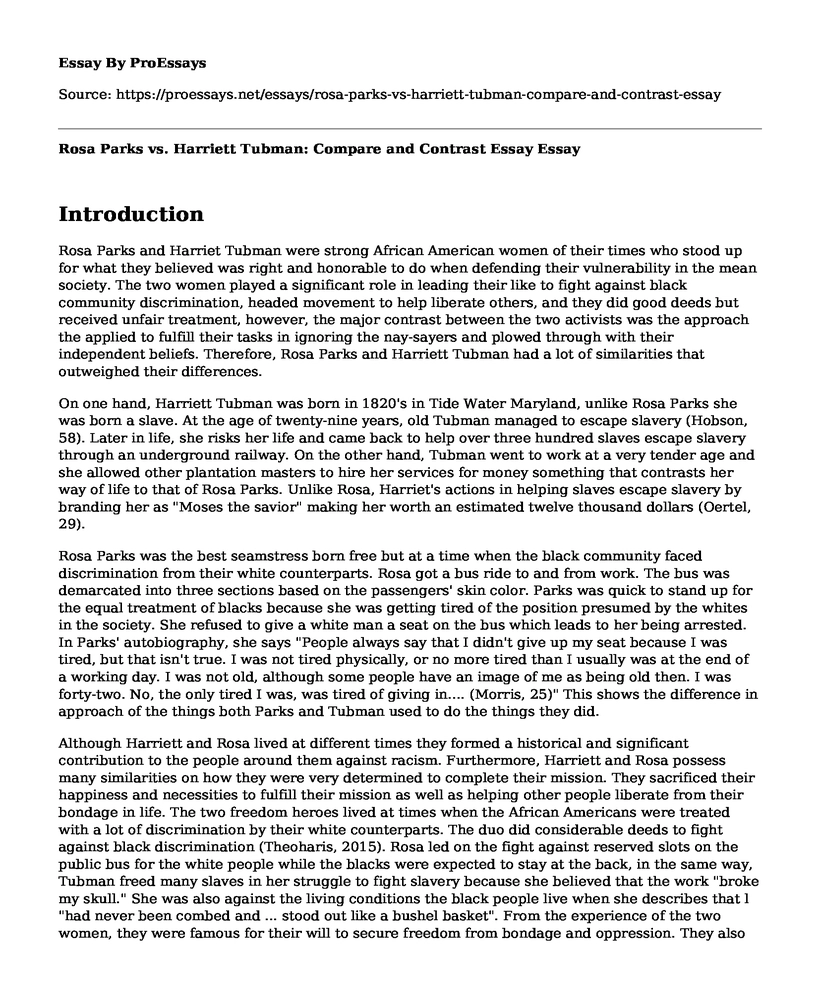Introduction
Rosa Parks and Harriet Tubman were strong African American women of their times who stood up for what they believed was right and honorable to do when defending their vulnerability in the mean society. The two women played a significant role in leading their like to fight against black community discrimination, headed movement to help liberate others, and they did good deeds but received unfair treatment, however, the major contrast between the two activists was the approach the applied to fulfill their tasks in ignoring the nay-sayers and plowed through with their independent beliefs. Therefore, Rosa Parks and Harriett Tubman had a lot of similarities that outweighed their differences.
On one hand, Harriett Tubman was born in 1820's in Tide Water Maryland, unlike Rosa Parks she was born a slave. At the age of twenty-nine years, old Tubman managed to escape slavery (Hobson, 58). Later in life, she risks her life and came back to help over three hundred slaves escape slavery through an underground railway. On the other hand, Tubman went to work at a very tender age and she allowed other plantation masters to hire her services for money something that contrasts her way of life to that of Rosa Parks. Unlike Rosa, Harriet's actions in helping slaves escape slavery by branding her as "Moses the savior" making her worth an estimated twelve thousand dollars (Oertel, 29).
Rosa Parks was the best seamstress born free but at a time when the black community faced discrimination from their white counterparts. Rosa got a bus ride to and from work. The bus was demarcated into three sections based on the passengers' skin color. Parks was quick to stand up for the equal treatment of blacks because she was getting tired of the position presumed by the whites in the society. She refused to give a white man a seat on the bus which leads to her being arrested. In Parks' autobiography, she says "People always say that I didn't give up my seat because I was tired, but that isn't true. I was not tired physically, or no more tired than I usually was at the end of a working day. I was not old, although some people have an image of me as being old then. I was forty-two. No, the only tired I was, was tired of giving in.... (Morris, 25)" This shows the difference in approach of the things both Parks and Tubman used to do the things they did.
Although Harriett and Rosa lived at different times they formed a historical and significant contribution to the people around them against racism. Furthermore, Harriett and Rosa possess many similarities on how they were very determined to complete their mission. They sacrificed their happiness and necessities to fulfill their mission as well as helping other people liberate from their bondage in life. The two freedom heroes lived at times when the African Americans were treated with a lot of discrimination by their white counterparts. The duo did considerable deeds to fight against black discrimination (Theoharis, 2015). Rosa led on the fight against reserved slots on the public bus for the white people while the blacks were expected to stay at the back, in the same way, Tubman freed many slaves in her struggle to fight slavery because she believed that the work "broke my skull." She was also against the living conditions the black people live when she describes that l "had never been combed and ... stood out like a bushel basket". From the experience of the two women, they were famous for their will to secure freedom from bondage and oppression. They also risked so much because when Tubman escaped slavery she came back risking her own life to rescue other slaves. On the same not, Parks was arrested because of her struggle to have other black people considered significant in the discriminative society they were living in (Morris, 25).
Conclusion
In conclusion, Rosa Parks and Harriett Tubman played significant roles in the civil rights of the people of their times making them have multiple similarities in their strong-willed spirit to fight injustices against the black community. However, their approaches in executing their desires were different yet the achieved so many commonnesses in results.
Works Cited
Hobson, Janell (July 2014). "Between History and Fantasy: Harriet Tubman in the Artistic and Popular Imaginary". Meridians: Feminism, Race, Transnationalism. Indiana University Press. 12 (2): 50-77. doi:10.2979/meridians.12.2.50
Morris, Aldon. "Rosa Parks, Strategic Activist (sidebar)". Contexts. Sage. Summer 2012, 11 (3): 25. doi:10.1177/1536504212456178.
Oertel, Kristen T. (2015). Harriet Tubman: Slavery, the Civil War, and Civil Rights in the 19th Century. Routledge. pp. 28-29, 34.
Theoharis, Jeanne. The Rebellious Life of Mrs. Rosa Parks, Beacon Press, 2015, ISBN 9780807076927
Cite this page
Rosa Parks vs. Harriett Tubman: Compare and Contrast Essay. (2022, Jul 18). Retrieved from https://proessays.net/essays/rosa-parks-vs-harriett-tubman-compare-and-contrast-essay
If you are the original author of this essay and no longer wish to have it published on the ProEssays website, please click below to request its removal:
- European Refugee Crisis and How It Began Essay
- Gender Discrimination at Workplaces Essay
- Paper Example on Poverty: A Denial of Choices and Human Dignity
- Essay Example on 19th-Century Homosexuality & Female Impersonation: A Historical Overview
- End Discrimination: Let Everyone Have Equal Opportunities - Essay Sample
- Migration to the US: Exploring the Legal and Illegal Routes - Essay Sample
- Free Paper Sample on Unmasking Human Trafficking: A Closer Look







